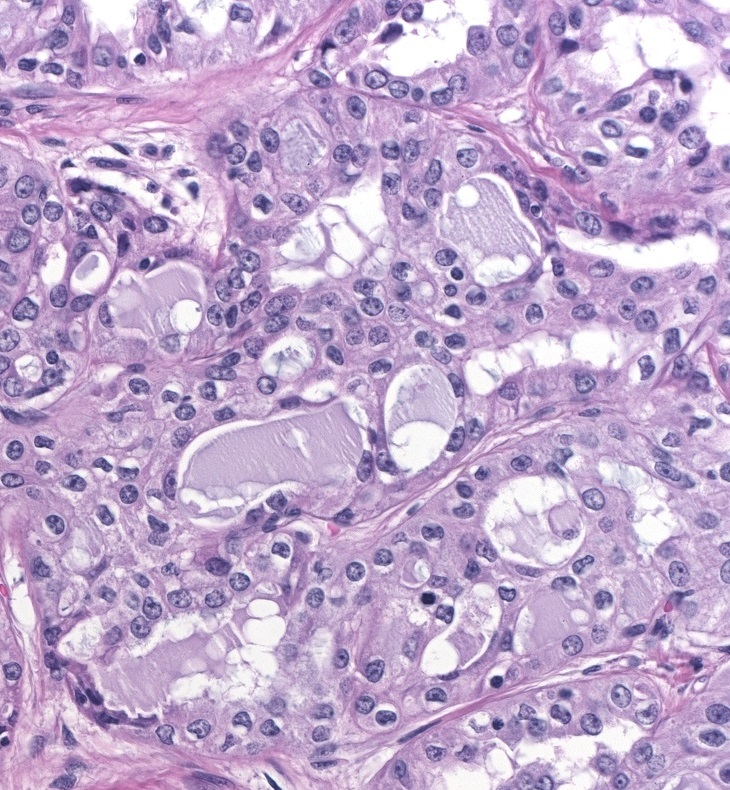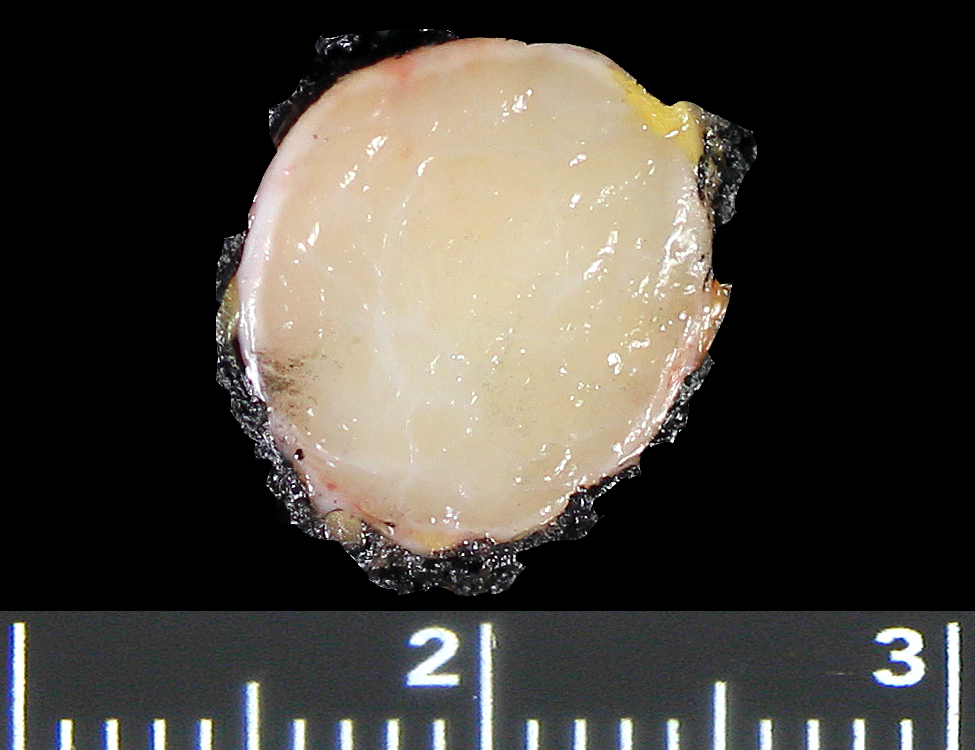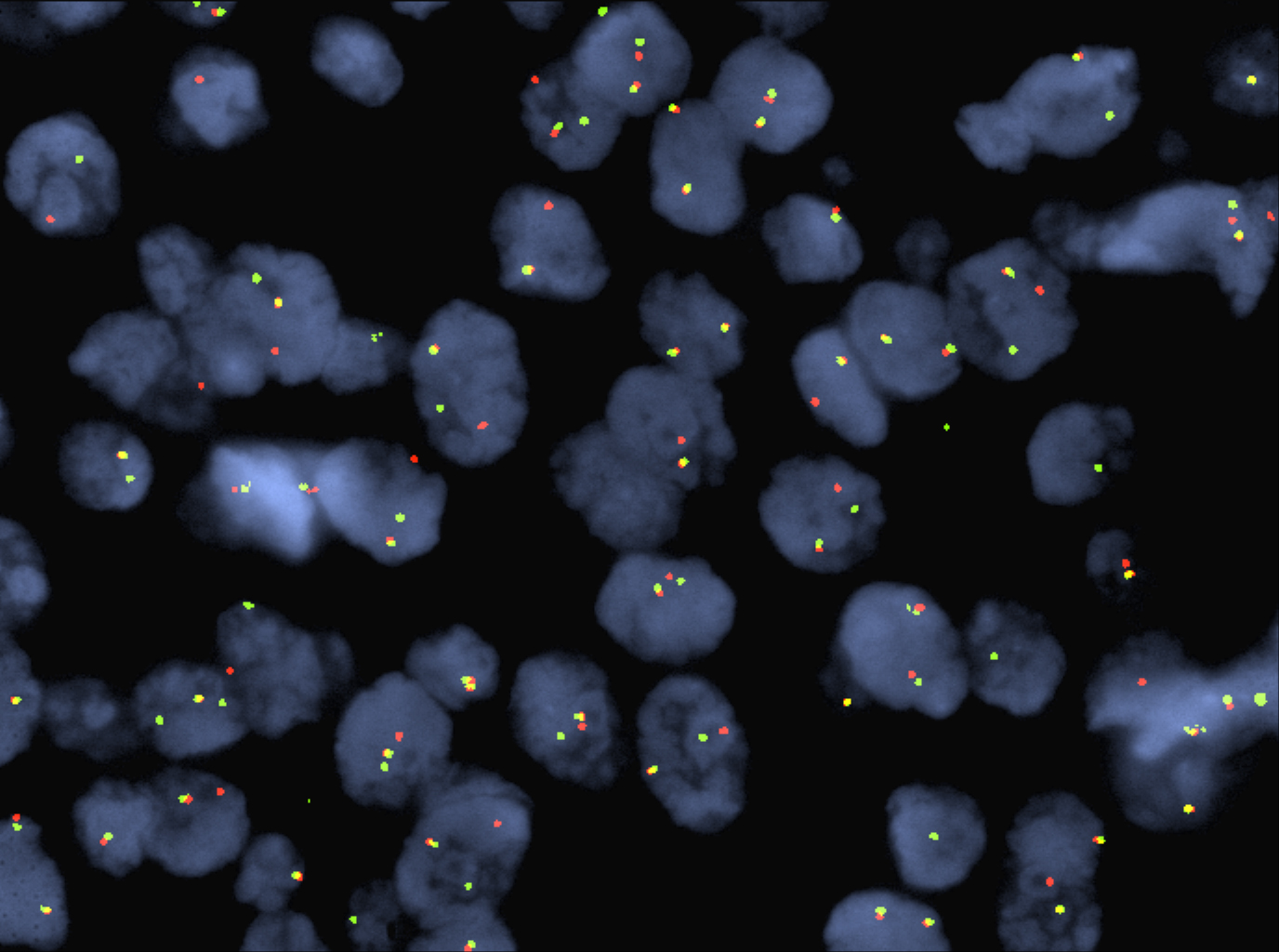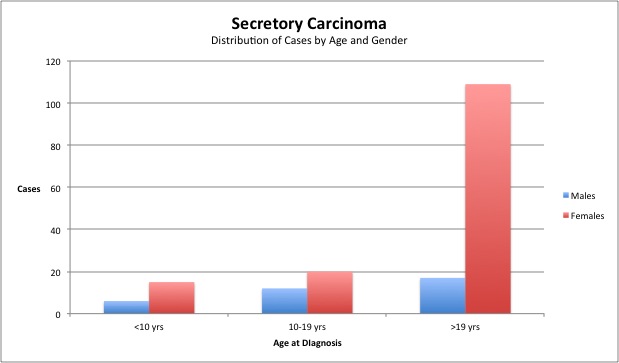Difference between revisions of "Secretory Carcinoma"
| Line 1: | Line 1: | ||
| − | __NOCACHE__ | + | __NOCACHE__ |
{{:TOC}} | {{:TOC}} | ||
| − | == | + | <br> |
| − | + | == Introduction == | |
| − | + | {{dxintronodisc|Secretory Carcinoma|Secretory carcinoma is a type of ductal carcinoma with characteristic clinical and morphological features.|Secretory carcinoma constitutes the most common type of breast carcinoma in children, but most cases arise in adult women.|The carcinoma often forms a well defined; rubbery; lobulated; white, tan, or gray mass with a glisteneing surface.|Sections show a circumscribed mass divided by fibrous septa and consisting of low-grade cells with either secretory or apocrine features or both.|Apocrine carcinoma (lack of secretions, no t(12;15) translocation) (Apocrine carcinoma is a rare type of ductal carcinoma in which the neoplastic cells contain abundant, eosinophilc cytoplasm and apocrine-type nuclei.)||37-1 Sec-intro-2.jpg|Secretory carcinoma has a characteristic gene fusion (ETV6-NTRK3).}} | |
| − | |||
| − | |||
| − | |||
| − | |||
| − | |||
| − | |||
| − | |||
| − | |||
| − | |||
| − | |||
{{img4|37-2 Gross-2.jpg}} | {{img4|37-2 Gross-2.jpg}} | ||
Latest revision as of 08:55, July 17, 2020
Contents
Introduction
|
Definition: Secretory carcinoma is a type of ductal carcinoma with characteristic clinical and morphological features. Clinical Significance: Secretory carcinoma constitutes the most common type of breast carcinoma in children, but most cases arise in adult women. Gross Findings: The carcinoma often forms a well defined; rubbery; lobulated; white, tan, or gray mass with a glisteneing surface. Microscopic Findings: Sections show a circumscribed mass divided by fibrous septa and consisting of low-grade cells with either secretory or apocrine features or both. Differential Diagnosis: Apocrine carcinoma (lack of secretions, no t(12;15) translocation) (Apocrine carcinoma is a rare type of ductal carcinoma in which the neoplastic cells contain abundant, eosinophilc cytoplasm and apocrine-type nuclei.) |
 |
 |
|
| Fibrous septa divide the mass into compact aggregates. The aggregates can have glandular, microcystic, or papillary patterns. Although the borders of the mass appear well defined, one can usually find subtle evidence of invasion. |  |
| The tumor cells vary from secretory to apocrine in their features. Cells of a secretory nature possess pale to clear, pink or amphophilic cytoplasm that contains abundant secretion. The nuclei appear low-grade and they vary from small to modest in size. The chromatin ranges from dark and finely dispersed to pale and granular. Nuclei with pale chromatin usually contain small, uniform nucleoli. |  |
| Cells with apocrine features contain granular eosinophilic cytoplasm and nuclei characteristic of apocrine cells. One usually finds both types of cell in a carcinoma, although one type or the other can dominate. The cells do not display noticeable mitotic activity or necrosis. |  |
| Secretion accumulates in the tumor cells, in the glands formed by the tumor cells, and in the microcystic spaces associated with the tumor cells. The secretory material appears pale pink or amphophilic with H&E staining and it often contains lacunae, which create a bubbly appearance |  |
| The secretion stains with the PAS method and is resistant to diastase digestion. (A PAS stain after treatment with diastase) |  |
| The carcinoma cells stain for keratin, and virtually all secretory carcinomas stain for S-100 protein. The absence of S-100 should make you reconsider the diagnosis of secretory carcinoma. (A stain for keratin) |  |
| Genetic studies demonstrate a fusion of the ETV6 and NTRK3 genes. One does not ordinarily need the results of genetic studies to make the diagnosis of secretory carcinoma, but one should think very carefully about making that diagnosis in the absence of the fusion gene. (In this "split apart" preparation, the 3' end of the NTRK3 gene is labeled with a red probe and the 5' end with a green probe. Side-by-side signals indicate an intact NTRK3 gene, whereas separated signals highlight a disrupted NTRK3 gene.) |  |
| Secretory carcinoma constitutes the most common type of breast carcinoma in children, but most cases arise in adults. |  |